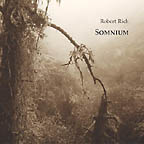
Here's more information about Robert Rich's 7 hour DVD:
| Return to Main Site |
 |
Here's more information about Robert Rich's 7 hour DVD: |
|
I recorded Somnium over a period of about eight years. When I started collecting field recordings for the project, high resolution gear was unavailable, so I recorded the project at 16 bit 48KHz resolution. I would have preferred a 24 bit recording, but in this case I was limited both by the recording medium and the carrying medium. Regarding the carrying medium, DVD simply cannot hold 7 hours of 24 bit audio without compression, and the artifacts of AC3 compression are worse than the sound of 16 bit encoding. (Remember that I decided not to release it as DVD-A because the medium had not been adopted yet, so I could not use MLP - Meridian Lossless Packing, a compression scheme that does not damage the sound.) Regarding the recording medium, I made most of my field recordings on a 16/48 Sony protable DAT machine. The system had to be portable enough to fit in a backpack, and cheap enough to risk damage in damp environments. So, with 16 bit source material and a 16 bit final mix, the advantages of 24 bits would have been lost. A wide dynamic range was not desirable with this recording, since it needs to keep an even enough volume to stay audible at very low overall levels. On the other hand, high resolution and imaging detail are essential to recreate the soundstage and wide ambience. I mixed the music so that it can hover at the threshold of one's attention during the night, without calling attention to itself. Yet, I wanted the sonic texture to be interesting enough to reward close attention. These goals sound contrary, but I found I could resolve them by mixing the music while monitoring at normal listening levels, then mastering it while monitoring at very low volumes to make sure that the dynamics stayed even. At low volumes, midrange frequencies will appear to predominate in a mix, so careful mixing and judicious EQ help to preserve the desired tonal balance when quiet. The mix has a more extreme "smiley curve" than would have been appropriate for louder listening levels. For field recordings, I used a Benchmark portable mic preamp, with a Sony TCD-D7 DAT machine, and a selection of microphones including a Crown SASS-P binaural mic, a spaced pair of omni Neumann KM130, or near-coincident cardioid AKG 451. I would use the Crown in high risk situations, such as the time I hung it over a cliff in Big Sur to capture some sloshing waves in a cove 30 feet below me. My main fear was that the weight of the microphone and cables would pull the preamp and DAT over the edge with it, although I probably should have been worrying more about my own safety, as half of my torso was leaning out over the cliff to keep the mic from hitting the rocks as I lowered it down onto a shelf above the waves. One of the more interesting recordings for Somnium took place in a lab at Scripps Oceanographic Institute, where an acquaintance was studying a species of tropical fish that creates audio fequency electrical oscillations from its skin. We placed about 16 fish in a bucket with three differential electrodes (positive, negative and reference), plugged into a battery powered Grass medical preamp designed for EEG. With the output of the preamp plugged directly into the portable DAT, we recorded a cloud of slowly shifting drones. Each fish emits a unique frequency as a sort of territorial marker, and as the fish lazily circulate around the bucket, individual tones become louder or softer in a very nonhuman slow motion symphony. The DVD authoring process held numerous unpleasant surprises. Nobody had tried putting such a long continuous track on a disk before. We learned that neither the authoring software nor the DVD itself could handle a single file larger than about 2 Gbytes, even though the medium could hold 4.7 Gig. Furthermore, DVD players require a certain amount of file size overhead that limits the practical maximum to about 4.3 Gig. Furthermore, if you wish to navigate or fast forward through the audio you need to add a frame of video to each frame of audio, which basically cuts in half your maximum audio file duration. In other words, after carefully editing the music so that it would fill the maximum duration that a DVD could hold, I learned it wouldn't fit. The authoring house gave me two choices: either AC3 encode the audio or omit the navigation. They sent me a sample with the mildest 2:1 AC3 encoding, but the compression destroyed the high frequency spatial detail and it made the midrange sound congested and lumpy. I decided to sacrifice the navigation so I could use straight PCM files. The audio still wouldn't quite fit because of the extra file overhead, so I selected a region in the middle of the piece that survived the AC3 encoding better than the rest, and we compressed that middle region. In any case, we needed to separate the audio into three regions because of the 2 Gig file size limitation. Unfortunately, many DVD players will briefly mute their audio playback when they encounter the two file boundaries in the middle of the piece; so, we had to select two very quiet moments in an otherwise continuous piece of music so that the mutes would not be too noticeable.
|
|
Here's more information about Robert Rich's 7 hour DVD: |
| Return to Main Site |